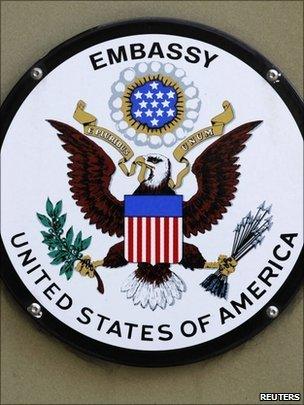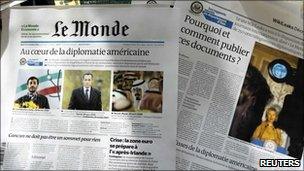US embassy cables: The background
- Published

The US has strongly criticised the release of the documents
The latest batch of documents to be released by Wikileaks is made up of diplomatic messages sent from US embassies around the world.
The whistle-blowing website says it has obtained more than 250,000 cables passed between the US State Department and hundreds of American diplomatic outposts - but it has so far only published a small sample of those messages.
However, the entire archive of the reports from US diplomats out in the field has been made available to five publications - the New York Times, external, the Guardian, external in the UK, France's Le Monde, external, El País, external in Spain and Germany's Der Spiegel, external.
It is the third mass Wikileaks, external release of classified documents since the publication of 77,000 secret US files on the Afghan conflict in July, and 400,000 documents about the Iraq war in October.
Suspicion has again fallen on US Army private Bradley Manning, an intelligence analyst arrested in Iraq in June and charged over an earlier leak.
In July the US Department of State revealed he had access to the Secret Internet Protocol Router Network (Siprnet) - a system which allows government and diplomatic information to be shared.
Millions of words
Wikileaks says the material it has obtained will be released in stages over the next few months because, "the subject matter of these cables is of such importance, and the geographical spread so broad, that to do otherwise would not do this material justice".
The full batch consists of 251,287 documents, comprising 261,276,536 words - which the website says is seven times the size of its Iraq documents release.
The cables cover messages sent between 1966 and 2010 and originate from 274 US embassies, consulates and diplomatic missions, the website says.
The New York Times, in a note to readers on its website, external, says the group of five US and European papers that gained access to the diplomatic material have been trawling through it for several weeks and agreed to begin publication of articles based on the cables on Sunday.
Defending the release of the documents, the paper argues they "serve an important public interest, illuminating the goals, successes, compromises and frustrations of American diplomacy in a way that other accounts cannot match".
White House 'consulted'
About 11,000 of the cables are marked "secret", the paper says, with another 9,000 carrying the label "noforn" - meaning they should not to be shared with other countries - and 4,000 marked "secret/noforn". The rest are said to be "confidential" or unclassified.
But the Times also reveals it has excluded information that it believes would endanger informants or national security. It has also consulted the Obama administration over some of the content, it says.

Le Monde was one of five newspapers to have early access to the documents
About 100 cables - some edited, some in full - will be published on its website, the paper adds.
In the UK, the Guardian also says it does not intend to "dump" the entire database into the public domain or to publish names that would endanger the safety of individuals.
"The news organisations have redacted some of the cables in order to protect a number of named sources and so as not to disclose certain details of current special operations," the paper says in a note from editors, external. "We have shared our redactions with Wikileaks."
The Guardian, which says it was given the contents of the leaked cables on a memory stick, also explains it will not be reporting on certain cables at all "owing to the nature of sourcing or subject matter".
"Our domestic libel laws impose a special burden on British publishers," it adds.